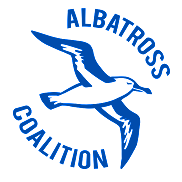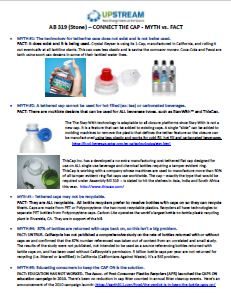MYTH #1: The technology for tethering caps does not exist and is not being used.
FACT: It does exist and it is being used. Crystal Geyser is using its 1-Cap, manufactured in California, and rolling it out eventually at all bottling plants. This cap uses less plastic and is saving the company money. Coca-Cola and Pepsi are both using sport cap designs in some of their bottled water lines.
MYTH #2: A tethered cap cannot be used for hot filled (ex: tea) or carbonated beverages.
FACT: There are multiple designs that can be used for ALL beverage types, such as StayWith™ and ThisCap.
The The Stay-With technology is adaptable to all closure platforms since Stay-With is not a new cap. It is a feature that can be added to existing caps. A single “slide” can be added to molding machines to remove the plastic that defines the tether feature so the closure can be manufactured using less plastic and works for cold fill, hot fill and carbonated beverages.
https://food-beverage.aptar.com/en-us/technologies/stay.html
ThisCap Inc. has a developed a no extra manufacturing cost tethered flat cap designed for use on ALL single use beverage and chemical bottles requiring a tamper evident ring. ThisCap is working with a company whose machines are used to manufacture more than 50% of all tamper evident ring flat caps use worldwide. The cap – exactly the type that would be required under Assembly Bill 319 — is slated to hit the shelves in Asia, India and South Africa this year. http://www.thiscap.com/
MYTH #3 – Tethered caps may not be recyclable.
FACT- They are ALL recyclable. All bottle recyclers prefer to receive bottles with caps on so they can recycle them. Caps are made from PET or Polypropylene- the two most recyclable plastics. Recyclers all have technologies to separate PET bottles from Polypropylene caps. Carbon-Lite operates the world’s largest bottle-to-bottle plastic recycling plant in Riverside, CA. They are in support of the bill.
MYTH #4: 87% of bottles are returned with caps back on, so this isn’t a big problem.
FACT: UNTRUE. CalRecycle has not published a comprehensive study on the rate of bottles returned with or without caps on and confirmed that the 87% number referenced was taken out of context from an unrelated and small study. The results of the study were not published, not intended to be used as a source referencing bottles returned with bottle caps on, and has been used without CalRecycle’s permission. 5 billion bottle caps per year are not returned for recycling (i.e. littered or landfilled) in California (Californians Against Waste). It’s a BIG problem.
MYTH #5: Educating consumers to keep the CAP ON is the solution.
FACT: EDUCATION HAS NOT WORKED. The Assoc. of Post-Consumer Plastics Recyclers (APR) launched the CAPS ON education campaign in 2010. There’s been no reduction in cap litter counted in annual litter cleanup events. Here’s an announcement of the 2010 campaign launch: https://earth911.com/food/the-verdict-is-in-keep-the-bottle-caps-on/
# # #

